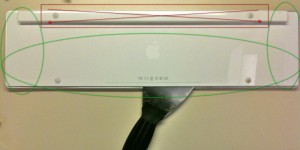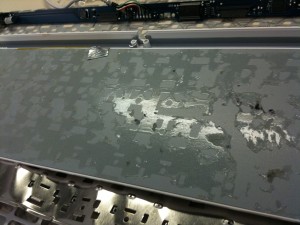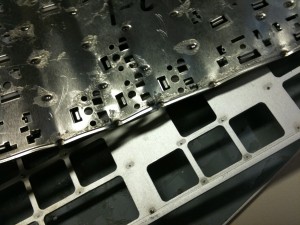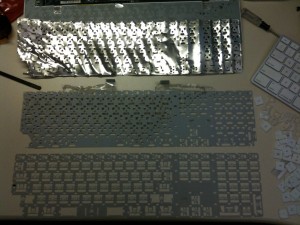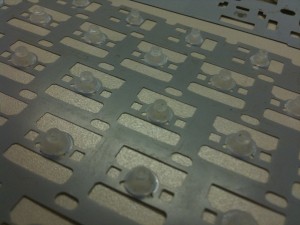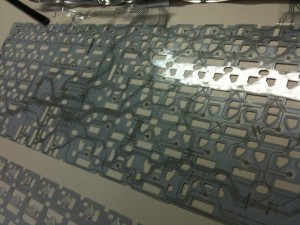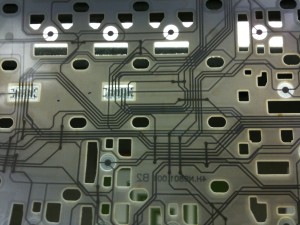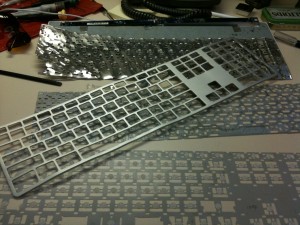So – you (or one of your users) spills coffee on an Apple keyboard — what to do?
Well with previous models, they could disassembled with some some effort, and be washed. (G5 KB, G4 KB, & more)
Well I don’t think this is gonna be happening for the new keyboards…
First, no screws, only adhesive and welds.
You can work it open with a putty knife. Avoid the red areas at the top, that is the extent of the arms of the ribbon cable inside, a putty knife will wreck them quite quickly.
Once you worked the putty knife all around the safe areas, attempt to pull the white plastic bottom (with a metal backer glued to it) open like a book, pivoting on the area you couldn’t work around.
That’s about it… You can unscrew the USB interface from the white plastic well, but the cord is captive, because the wires are soldered to the board. You can desolder the wires from the board or snip the white plastic if you want take the board out.
The keyboard itself is attached to the aluminum top with 147 welds, rather than the ~30 screws it used to have.
I was able to pull it off using some vice grips on a corner I pried up.
There’s no going back after this, both frames will bend and warp as the welds pop off.
So you’ll be left with a bunch of keys still attached to the keyboard on little white plastic clips in various ways.
These keys are all attached the same and are easy to take off: Top row keys, arrow keys, Option, Command, Shift, return, tab, caps lock, Space.
They will have a plastic mechanical that has small plastic tabs in the metal frame, just push the tiny nub out of the fram and key is free.
The letter keys however I found difficult, the key top can be taken off easily by pulling up sideways but the plastic underneath is hooked on top and bottom by the metal frame. It needs to be pushed from the bottom toward the top and a black stick put under the top corner so it pops off the frame’s hook, the same can be done, for the other side, or if you twist it right, it will unhook from the bottom and come off.
After you have taken all the bottom plastic key mechanicals off, you can easily take off the two plastic layers.
The top layer is a simple plastic sheet with the rubber nipples that press down and give the keys spring.
The next layer is new, what was once three sheets (two sheets of circuit traces and a buffer in between) is now one laminated whole . While you’d hope this makes the keyboard more impervious to spills and perhaps it does, it precludes the ability to wash and dry like the old keyboards. (You had to act quick though, coffee and coke eat though the traces really fast!) Putty knives are also really bad for circuit traces (see the mangled ribbon cable)
Well that’s about all I learned, next time perhaps I will try simply soaking the keyboard in water then drying for a week or two, but a chance at some first hand dissection was too tempting. :)
